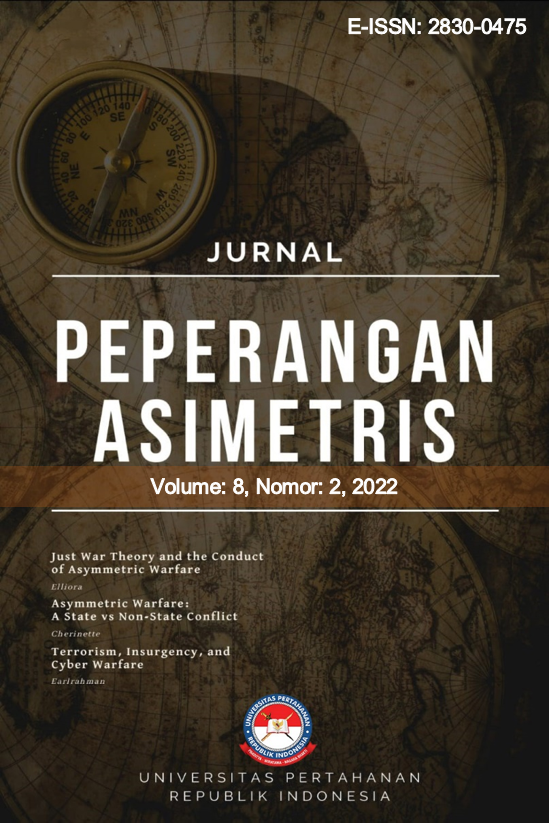THE ASYMMETRIC-COMPARATIVE ANALYSIS OF STRAITS OF HORMUZ AND STRAITS OF MALACCA
DOI:
https://doi.org/10.33172/pa.v8i2.1482Abstrak
Since thousands of years ago, seas and straits have become world trade routes. The sea carries out the exchange of goods and trade. The purpose of this article is to explain the mastery of the potential of the strait; It has implications for the glory of the country that controls it. Through an asymmetrical analysis, colonials' domination of the straits is relatively safer than areas controlled by regional countries. Sea lanes between islands and between continents are strategic resources that can be exploited by anyone who occupies them. The Hormuz Strait and the Malacca Strait are clear examples of how vital the strait is for the movement of goods and trade routes involving many national interests. On that basis, many conflicts occurred in these two straits. The traditional approach and realism in viewing the conflict in the two straits prove that, in the end, every country or country with interest will have an ego to dominate. The conflicts that occur in the two straits are border and resource conflicts.Referensi
Boege, V. (2006). Traditional Approaches to Conflict Transformation-Potentials and Limits.
Bove, G., Okada, A., Vicari, D. (2021). Cluster Analysis for Asymmetry. In: Methods for the Analysis of Asymmetric Proximity Data. Behavior metrics: Quantitative Approaches to Human Behavior, vol 7. Springer, Singapore. https://doi.org/10.1007/978-981-16-3172-6_4
Byrnes, P. (2018). Evolution of Auditing: From the Traditional Approach to the Future Audit1. In Continuous auditing. Emerald Publishing Limited.
Caitlyn, T. (2008). Assessing the Iranian Threat to the Strait of Hormuz. http://www.eia.doe.gov/emeu/cabs/
Carlos Pascual. (2008). The Geopolitics of Energy From Security to Survival.
Chuan, G. K. , & C. M. (2005). Environment and Development in the Straits of Malacca. Routledge.
Cohen, S. B. (2014). Geopolitics : The Geography of International Relations. Rowman and Littlefield.
Dilip Hiro. (1991). The Longest War: The Iran-Irak Military Conflict. Routledge.
Dunne, T. , K. M. , & S. S. (2013). International Relations Theories : Discipline and Diversity. Oxford University Press.
Katzman, K. (2012). CRS Report for Congress Iran’s Threat to the Strait of Hormuz. www.crs.gov
Lyons, M. (1994). Napoleon Bonaparte and the legacy of the French Revolution.
Mhd Halkis. (2018), Strategic Cultural Footprint of Colonial Diplomacy: Singaporean Interaction with the Neighbourhood of Maritime Society of Belakang Padang (Batam, Indonesia), Proceedings of 1st Workshop on Environmental Science, Society, and Technology, WESTECH 2018, December 8th, 2018, Medan, Indonesia, https://eudl.eu/doi/10.4108/eai.8-12-2018.2283893
Saeri, M. (2013). Karakteristik dan Permasalahan Selat Malaka. In Jurnal Transnasional (Vol. 4, Issue 2).
U.S. Energy Information Administration. (2017). World Oil Transit Chokepoints. Https://Www.Eia.Gov/Todayinenergy.
World Atlas. (2022). Strait’s Strategic Importance. https://Www.Worldatlas.Com/Straits/Strait-of-Hormuz.Html.
Unduhan
Diterbitkan
Cara Mengutip
Terbitan
Bagian
Lisensi
Proposed Policy for Journals That Offer Open Access. Authors who publish with this journal agree to the following terms:
- Authors retain copyright and grant the journal right of first publication with the work simultaneously licensed under a Creative Commons Attribution License that allows others to share the work with an acknowledgment of the work's authorship and initial publication in this journal.
- Authors are able to enter into separate, additional contractual arrangements for the non-exclusive distribution of the journal's published version of the work (e.g., post it to an institutional repository or publish it in a book), with an acknowledgment of its initial publication in this journal.
- Authors are permitted and encouraged to post their work online (e.g., in institutional repositories or on their website) prior to and during the submission process, as it can lead to productive exchanges, as well as earlier and greater citation of published work (See The Effect of Open Access).
Proposed Policy for Journals That Offer Delayed Open Access. Authors who publish with this journal agree to the following terms:
- Authors retain copyright and grant the journal right of first publication, with the work [SPECIFY PERIOD OF TIME] after publication simultaneously licensed under a Creative Commons Attribution License that allows others to share the work with an acknowledgment of the work's authorship and initial publication in this journal.
- Authors are able to enter into separate, additional contractual arrangements for the non-exclusive distribution of the journal's published version of the work (e.g., post it to an institutional repository or publish it in a book), with an acknowledgment of its initial publication in this journal.

